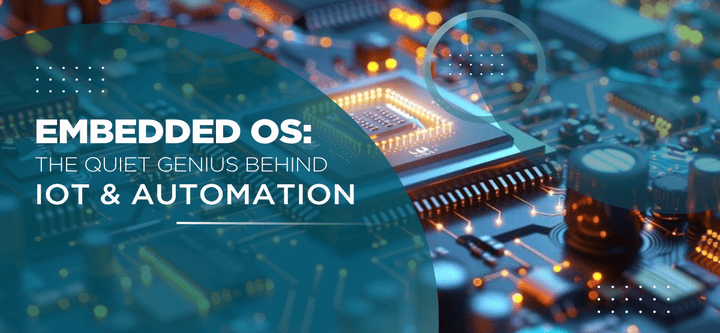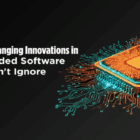From wearable fitness trackers and smart home devices to autonomous vehicles and industrial robots, embedded operating systems (OSes) are the silent force driving the ever-expanding world of IoT (Internet of Things) and automation. While futuristic technology is often associated with AI-powered robots or high-tech gadgets, the true enabler of these innovations is the software running behind the scenes—optimized to handle tasks efficiently, reliably and in real time.
Unlike traditional operating systems designed for computers and smartphones, embedded OSes are lightweight, efficient and tailored for specific hardware with limited resources. They ensure seamless communication, precise control and energy efficiency across a wide range of devices, from smart appliances and medical monitoring systems to industrial automation and self-driving cars.
This blog delves into the world of embedded operating systems, exploring their architecture, functionality and critical role in shaping the future of IoT and automation. By the end, you’ll understand why embedded OSes are the backbone of modern connected technology, enabling billions of devices to operate intelligently, efficiently and securely.
What Is an Embedded Operating System?
An embedded operating system (OS) is a specialized software designed to manage and control an embedded system—a combination of hardware and software built for a dedicated function. Unlike general-purpose operating systems such as Windows, macOS, or Linux, which support a variety of applications and multitasking, embedded OSes are optimized for real-time performance, efficiency and stability within constrained computing environments.
Embedded OSes are commonly found in consumer electronics, industrial machines, medical devices, automotive systems and IoT (Internet of Things) devices. For instance, the OS in a smart thermostat efficiently manages temperature control, communicates with a smartphone, and ensures energy efficiency—all while operating on minimal computing power.
These systems often have real-time operating system (RTOS) capabilities, meaning they process tasks with precise timing requirements, crucial for applications like automated vehicles, medical monitoring devices and robotics. Additionally, embedded OSes prioritize low power consumption, security and reliability, making them ideal for devices with limited memory, storage and processing power.
Examples of popular embedded operating systems include:
- FreeRTOS – Lightweight OS for IoT and embedded applications
- VxWorks – Used in aerospace, automotive, and medical industries
- Embedded Linux – A modified Linux version for industrial applications
- RTEMS (Real-Time Executive for Multiprocessor Systems) – Used in mission-critical environments
By focusing on specific tasks, minimal resource usage, and real-time performance, embedded operating systems play a vital role in modern technology, enabling the seamless operation of billions of connected devices worldwide.
How Does an Embedded Operating System Work?
At its core, an embedded operating system (OS) is designed to efficiently manage a device’s hardware and software resources while ensuring real-time functionality and reliability. Unlike general-purpose OSes that handle a wide variety of tasks, embedded OSes are purpose-built for specific functions, prioritizing performance, power efficiency and minimal resource consumption.
These systems are optimized to:
- Control hardware components with minimal latency
- Execute real-time tasks with precise timing requirements
- Optimize power consumption, crucial for battery-operated devices
- Ensure stability and security in critical applications like automotive systems, medical devices and industrial automation
For example, an embedded OS in a pacemaker must process heart rate data and deliver electrical pulses in real time, ensuring the patient’s safety. Similarly, in autonomous vehicles, embedded OSes manage sensor fusion, real-time decision-making and communication with vehicle control systems.
Most embedded OSes operate on Real-Time Operating System (RTOS) principles, meaning they prioritize time-sensitive tasks over less critical ones, ensuring smooth and predictable performance. These systems are often customized for the device they run on, making them lightweight, efficient and highly reliable, even in constrained environments with limited memory and processing power.
By balancing performance, real-time execution and resource efficiency, embedded operating systems power the backbone of modern technology, enabling everything from smart appliances and wearables to industrial automation and autonomous machines.
Core Functionalities of an Embedded Operating System
Embedded operating systems are designed with specialized functionalities that make them ideal for IoT, automation and real-time applications. These core features ensure efficiency, reliability and security, even in devices with constrained hardware resources.
1. Real-Time Processing
Most embedded OSes are built on Real-Time Operating System (RTOS) principles, ensuring that tasks are executed within a strict time frame. This is crucial for time-sensitive applications like:
- Medical devices (e.g., pacemakers, ventilators) that require immediate responses to patient conditions
- Automotive systems (e.g., ABS braking, collision detection) where delays can lead to safety risks
- Industrial automation (e.g., robotic arms, conveyor belts) that rely on precise timing for efficiency
2. Low Power Consumption
Embedded OSes are optimized for energy efficiency, making them ideal for battery-operated and low-power devices like:
- Wearable fitness trackers that need to last days on a single charge
- Smart home sensors that run for years on minimal power
- IoT devices deployed in remote locations, where power conservation is essential
Their lightweight architecture ensures they use only the necessary computational resources, reducing energy consumption and extending device lifespan.
3. Security Protocols
With the growing cybersecurity risks in IoT, embedded OSes incorporate built-in security features such as:
- Encryption to protect sensitive data
- Secure boot processes to prevent unauthorized modifications
- Access control mechanisms to restrict unauthorized users
These security measures ensure safe and reliable device operation, even in critical sectors like finance, healthcare and defense.
By combining real-time processing, power efficiency and advanced security, embedded operating systems serve as the foundation for next-generation IoT, automation and smart technology, enabling seamless and secure device operations across industries.
Real Life Examples of Embedded Operating System Devices
You may not realize it, but you encounter embedded operating systems daily. Here are some examples of where they exist:
- Smart Appliances: Modern refrigerators, ovens and washing machines equipped with internet connectivity, allowing users to control and monitor them remotely via apps or voice commands.
- Wearable Technology: Devices like smartwatches and fitness trackers that monitor health metrics, track physical activity and provide notifications directly to your wrist.
- Automotive Systems: Advanced systems like engine control units (ECUs) for optimizing vehicle performance and infotainment systems that provide navigation, entertainment and smartphone integration.
- Industrial Robots: High-tech automated assembly lines used in manufacturing to improve efficiency, precision and production speed.
- Medical Devices: Critical tools like pacemakers that regulate heartbeats, glucometers for monitoring blood sugar levels and hospital monitoring systems that track vital signs continuously for better patient care.
Embedded OSes excel in these devices because they focus entirely on one task while minimizing resource consumption.
Wide Variety Use cases of Embedded Operating Systems
Embedded OSes are at the forefront of numerous industries, enabling a wide range of applications. Some of their most common use cases include:
Home Automation
Embedded operating systems (OSes) are the backbone of smart home technology, enabling seamless communication between devices like smart locks, connected thermostats and automated lighting systems. These OSes ensure everything works together smoothly, providing convenience, energy efficiency and enhanced security for homeowners.
Industrial Automation
In modern factories, embedded OSes are critical for powering tools, conveyor belts and robotic systems. They play a vital role in ensuring precision, consistency and efficiency on production lines, helping businesses meet high-demand output while maintaining quality control. These systems also enable advanced monitoring and predictive maintenance, reducing downtime.
Automotive Technology
Embedded OSes are at the heart of modern vehicles, driving innovations like automatic braking, lane-keeping assist and GPS navigation. By integrating safety features and improving driver convenience, these systems enhance overall vehicle performance. They also support in-car entertainment systems and connectivity features, transforming the driving experience.
Healthcare
Embedded OSes are essential in healthcare devices, from wearable health monitors that track vital signs to life-saving machines like defibrillators and ventilators. These systems ensure tools deliver accurate, real-time data for both patients and medical professionals, improving diagnostics, treatment and patient outcomes.
Consumer Electronics
Everyday devices like gaming consoles, smart TVs and home assistants rely on embedded OSes to provide user-friendly interfaces and reliable performance. These systems manage complex functions behind the scenes, enabling smooth operation and seamless interactions for a better user experience.
Types of Embedded Operating Systems
Embedded operating systems can be categorized into several types based on their design, functionality, and intended purpose. These systems are tailored to meet the unique demands of specific devices and applications:
Single-Tasking OS
A single-tasking operating system is designed to handle one task at a time, making it suitable for devices with straightforward and limited functions. These systems are highly efficient, as they focus solely on completing one operation without the overhead of managing multiple processes. Examples of devices that use single-tasking OSes include simple calculators, digital alarm clocks and other basic electronic gadgets where multitasking is unnecessary.
Multi-Tasking OS
Multi-tasking embedded operating systems can handle multiple tasks or processes concurrently, making them ideal for more complex devices. These OSes efficiently allocate system resources to ensure smooth operation of various functions simultaneously. Applications that benefit from multi-tasking OSes include drones, which must manage navigation, camera stabilization and communication at the same time and smartphones, which juggle user apps, background processes and hardware interactions seamlessly.
Real-Time OS (RTOS)
Real-Time Operating Systems are designed to meet strict timing constraints, ensuring that tasks are executed within specific deadlines. RTOSes are critical for applications where delays could result in failure or danger, such as in medical devices, industrial automation systems, or autonomous vehicles. These systems prioritize reliability and predictability, guaranteeing fast, consistent responses essential for life-saving or high-precision tasks.
Embedded Linux
Embedded Linux is a versatile, open-source option for developing embedded systems. Known for its flexibility and wide array of features, it can be tailored to meet the needs of virtually any embedded application. Developers value Embedded Linux for its robust performance, security and extensive community support, which continuously contributes to its growth and improvement. It is commonly used in devices like smart TVs, routers and IoT devices that require a balance of functionality, scalability, and ease of development.
Embedded vs. Non-Embedded Operating System: What’s the Difference?
The key difference between embedded and non-embedded (or general-purpose) OSes lies in their functionality and scope:
| Aspect | Embedded OS | Non-Embedded OS |
| Purpose | Task-specific | General-purpose |
| Resource Usage | Lightweight, minimal resources | Heavy, significant resources |
| Flexibility | Customized for devices | Broad and adaptable |
| Examples | FreeRTOS, VxWorks | Windows, macOS, Linux |
While non-embedded OSes focus on versatility, embedded OSes prioritize specialization and efficiency.
Future Trends in Embedded OS Technology
Embedded operating systems (OS) are evolving rapidly, playing a pivotal role in the advancement of the Internet of Things (IoT) and automation sectors. Several emerging trends are shaping the future of embedded OS technology:
1. AI Integration
The incorporation of Artificial Intelligence (AI) into embedded systems is enabling devices to perform complex tasks such as predictive maintenance and data analysis. This integration facilitates real-time decision-making and enhances operational efficiency across various applications.
2. Enhanced Security Features
As IoT devices become more widespread, they present attractive targets for cyberattacks. To counter these threats, embedded OS developers are implementing advanced security mechanisms, including blockchain technology and AI-based threat detection systems, to safeguard data integrity and device functionality.
3. Edge Computing Support
To reduce latency and improve processing speeds, embedded OSes are increasingly supporting edge computing paradigms. This approach allows data to be processed locally on devices, minimizing reliance on cloud infrastructures and enhancing real-time responsiveness.
4. IoT Standardization
Efforts to standardize IoT protocols are underway to ensure seamless communication and interoperability among diverse devices. Standardization facilitates the integration of embedded OSes across various platforms, promoting a more cohesive and efficient IoT ecosystem.
These trends indicate a transformative period for embedded operating systems, positioning them at the forefront of technological innovation in IoT and automation.
How Evolute is Advancing Embedded Systems Technology
Evolute is at the forefront of embedded systems innovation, offering cutting-edge solutions in Fintech, EMS and Electro-tech. With a mission to “TechPower the world,” Evolute designs and develops high-performance embedded systems that enhance efficiency and reliability across industries. Their Fintech solutions, including POS machines and biometric devices, integrate advanced embedded OS technology for seamless financial transactions.
EvoFlex, a pioneering initiative under Evolute, is redefining Embedded Systems and Electronics Manufacturing Services (EMS) with innovative, high-performance solutions. Specializing in turnkey EMS and advanced embedded technologies, EvoFlex delivers precision-engineered hardware, firmware, and modular electronic solutions tailored for modern industries. Through continuous innovation and technological expertise, Evolute is driving the future of embedded systems in India and beyond.
Embedded OSes Are Driving the Future of IoT and Automation
Embedded operating systems may work quietly in the background, but their influence is undeniable. They’re driving innovations across industries, from enabling smarter homes and safer cars to creating efficient factories and improving healthcare technologies.
With the rapid integration of AI and enhanced security features, the potential of embedded OSes feels limitless. If you’re considering adopting IoT or automation solutions for your organization, understanding the role of embedded OSes is a vital first step.
Are you ready to explore the possibilities of embedded systems in your business? Stay tuned for more insights and trends in the rapidly evolving world of IoT.





